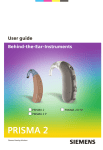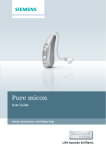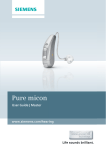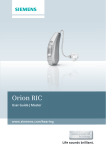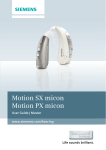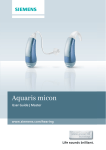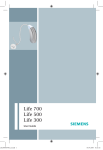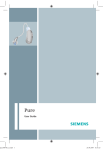Download Siemens Nitro BTE User guide
Transcript
Nitro BTE User Guide Content Content Your Nitro hearing instrument 4 Intended use 5 General notes on safety 6 Handling batteries 9 Inserting and removing your hearing instrument 12 Turning your hearing instrument on and off 13 Changing the hearing program 15 Changing the volume 16 Audio input 17 Telephoning 19 e2e wireless 2.0 21 Maintenance and care 22 Accessories 23 Troubleshooting tips 25 Technical information 26 Disposal information 28 Your hearing instrument configuration 29 2 Introduction Introduction EN Dear customer, Congratulations! You have selected a hearing instrument from Siemens. This hearing instrument was individually designed for your hearing impairment and is fitted specially to your personal hearing profile. These instructions, together with guidance from your Hearing Care Professional, will help you understand how your new hearing instrument works. If you have further questions, please contact your Hearing Care Professional. 3 Your Nitro hearing instrument Your Nitro hearing instrument Nitro SP (battery type: 675) ① Earhook ② Microphone openings ③ Volume control with on/off function ④ LED ⑤ Cover for programming socket 4 ⑥ Program button with on/off function ⑦ Audio input ⑧ Battery compartment ⑨ Typeplates red = right hearing instrument blue = left hearing instrument Intended use Intended use EN Hearing instruments are intended to improve the hearing of hearing impaired persons. Diagnosis and prescription of a hearing instrument must be performed by hearing health specialists, e.g. ENT doctors, audiologists or acousticians. Read and follow the instructions of this user guide to avoid injuries and to protect the hearing instruments from damage. Symbols: Be aware of information marked with the warning symbol WARNING, CAUTION or NOTICE! WARNING points out a situation that could lead to serious injuries, CAUTION indicates a situation that could lead to minor and moderate injuries. NOTICE NOTICE indicates possible property damage. Advice and tips on how to handle your device better. Instruction. Indicates that something has to be done. Indicates an option that not every hearing instrument has. Ask your Hearing Care Professional to check off the relevant information. 5 General notes on safety General notes on safety NOTICE Your hearing instruments are sensitive to extreme heat, high humidity, strong magnetic fields (> 0.1T), X-rays and mechanical stress. Do not expose your hearing instruments to extreme temperature or high humidity. Do not leave them in direct sunlight. Do not wear them in the shower or when you apply make-up, perfume, aftershave, hairspray or suntan lotion. Do not wear your hearing instruments when you are exposed to short-waves, a strong magnetic field, a high frequency field or X-rays. Do not place your hearing instruments in a microwave oven. 6 General notes on safety EN WARNING Choking hazard posed by small parts. If infants, small children or mentally disabled persons need to wear hearing instruments ensure adequate supervision. Check the integrity of the hearing instruments regularly. Ensure that your child does not detach the hearing instrument from the earmold. Consult your Hearing Care Professional if the housing is deformed. Keep the battery compartment locked. Verify the proper function of the locking mechanism. Keep batteries and accessories out of children's reach. If swallowed consult a physician or a hospital immediately. In some countries restrictions for the usage of wireless equipment exist. Refer to local authorities for further information. 7 General notes on safety NOTICE Batteries contain harmful substances that pollute the environment. Do not throw used batteries into household trash. Dispose batteries according to national regulations or return them to your Hearing Care Professional. NOTICE Leaking batteries damage the hearing instruments. Turn the hearing instruments off when not in use to preserve the battery. Remove batteries when the instruments are not in use for a prolonged period of time. WARNING Hazard of explosion in explosive atmospheres! Do not use your hearing instruments in areas where there is a danger of explosions (e.g. mining area). 8 Handling batteries Handling batteries EN Always use the right size batteries. Remove the tab on your batteries only when you are ready to use them. The positive (+) side of the batter- original size ies is always the smooth side. Always keep spare batteries with you. Low battery indicator Your Hearing Care Professional can activate an acoustic signal to inform you when the battery is nearly empty. If you hear an acoustic signal or experience low amplification power, replace the battery. 9 Handling batteries Inserting the battery Open the battery compartment completely using your fingernail as shown in the illustration. Insert the proper size battery. Make sure that the "+" symbol on the battery points up as shown in the picture. Close the battery compartment. Do not force the door shut. If it does not close easily, check to see if the battery was inserted properly. When the battery door is completely closed, your hearing instrument is ready for use. 10 Handling batteries EN Removing the battery Open the battery compartment completely. Normally the battery drops out when the compartment is completely open. If the battery does not come out, lightly tap the instrument or use the magnet stick available as accessory to remove the battery. 11 Inserting and removing your hearing instrument Inserting and removing your hearing instrument Ask your Hearing Care Professional to apply colored typeplates for side recognition. If the typeplate of your hearing instrument is in red, the hearing instrument is intended for the right ear. If the typeplate is in blue, the hearing instrument is for the left ear. Inserting your hearing instrument Turn your hearing instrument off. Hold the earmold between your thumb and index finger and insert it carefully into the ear canal. You may find it helpful to pull your ear slightly upward or to the back. Place your hearing instrument behind your ear. Turn your hearing instrument on. Removing your hearing instrument Hold the earmold between your thumb and index finger and carefully pull it out. You may find it helpful to lightly push your ear from the back. 12 Inserting and removing your hearing instrument Turning your hearing instrument on and off Via battery compartment Close the battery compartment completely to turn the hearing instrument on. Open the battery compartment downward to the first stop to turn the hearing instrument off. Via program button Press the program button for about 2 seconds to turn the hearing instrument to stand-by. Press the program button for about 2 seconds to turn the hearing instrument back on. Via volume control Rotate the volume control upwards to turn the hearing instrument on. Rotate the volume control completely down to turn the hearing instrument off. Via remote control Refer to the remote control user guide. Power-on delay Your hearing instrument is equipped with a "power-on delay" feature which can be activated by your Hearing Care Professional. This allows you to turn the hearing instrument on with an automatic delay of 6/12/18 seconds, so that you may insert the hearing instrument into your ear without experiencing unpleasant feedback (whistling). 13 EN Inserting and removing your hearing instrument Checking the hearing instrument's performance The LED shows whether the hearing instruments work properly. The LED shines constantly. The hearing instruments are switched on and sufficient battery power is available. The LED ist off. The hearing instruments are switched off or the battery must be replaced. To check if sufficient battery power is available use a battery tester or place the switched-on hearing instruments in your closed hand and listen if it responds with feedback whistling. Check the instrument sound regularly with a stethoclip, particularly if your child is not able to express verbally if something is wrong with the hearing instruments. 14 Changing the hearing program Changing the hearing program EN Via program button Your hearing instruments offer up to 5 hearing programs for specific listening environments. Each time you press the program button, your hearing instruments switch to the next program, confirming each change with an acoustic signal. Example Turn your hearing instruments on. It is automatically in program 1. You want to change to program 2. Press the program button once. You hear the acoustic signal for program 2. You are now in program 2. Press the program button shortly to change the program. Pressing the program button too long will switch off the hearing instruments. Via remote control Refer to the remote control user guide. Your Hearing Care Professional can write down the personal program configuration of your hearing instrument. See the table on last page. Your Hearing Care Professional can activate or deactivate the acoustic signals in your hearing instruments. 15 Changing the volume Changing the volume The volume of your hearing instruments is controlled automatically and there is no need to manually adjust it. Should you prefer manual volume control, your Hearing Care Professional can program the hearing instrument for manual adjustment. Via volume control Rotate the volume louder control with your index finger to select the desired listening volume. softer For easier handling your Hearing Care Professional may have activated the volume control only on one side. With e2e wireless the second hearing instrument is automatically adjusted. Via remote control Refer to the remote control user guide. When using a remote control the volume control is deactivated. 16 Audio input Audio input EN Your hearing instrument is equipped with an audio input. Together with an audio shoe it enables the connection between the hearing instrument and e. g. an FM system, mp3 player, television or an infrared device. This way the sound is coming directly from the sound source. That can be useful for adults in difficult listening situations and for children in classrooms. NOTICE Use only the M5 audio shoe (labelled inside the audio shoe). They are designed exclusively for your hearing instruments. With the audio shoe M5 attached, the battery compartment switch is disabled and the hearing system can only be switched off via program button or remote control. WARNING Risk of injuries caused by electric shock! Connect audio input only to a device conforming to IEC 60065 (IEC-Norm for audio, video and other electronic devices). 17 Audio input Attaching the audio shoe Open the battery compartment ①. Open the audio shoe cover ②. Close the battery compartment. Align the contacts of the audio shoe with the contacts of the hearing instrument. Slide the audio shoe over the hearing instrument until it snaps into the end position. Your Hearing Care Professional can program your hearing instruments so that they switch automatically to the audio shoe program if an audio shoe has been attached. Removing the audio shoe Slide the audio shoe in the opposite direction to that for attachment and take it off. Close the audio shoe cover. 18 Telephoning Telephoning EN Hold a telephone near your hearing instrument (*). The hearing instrument automatically switches to the telephone program. Move the telephone away from your hearing instrument. The hearing instrument switches back to the previously used program. You can also select the telephone program manually by using the program button. When operating the hearing instrument in telecoil mode, the wireless function may cause a pulsing noise. This is due to the pick-up of the transmission signal. When your hearing instrument is in telecoil mode please use the remote control only with a distance greater than 10 cm (4 inches). (*) AutoPhone magnet accessory Not all telephones produce a magnetic field strong enough to activate the AutoPhone function. In this case, use the AutoPhone magnet, available as an accessory, and attach it to the telephone receiver to activate the Auto-Phone function. 19 Telephoning See the AutoPhone magnet user guide for instructions on how to position the magnet. Use only the Siemens magnet. Ask your Hearing Care Professional for this accessory. WARNING Magnets may interfere with the operation of life supporting systems (e. g. pacemakers, magnetic valves). Use a magnet only if not in doubt about the safe distance. The safe distance between pacemaker and magnet should be at least 10 cm (4 inches). NOTICE Magnets can disturb electrical devices and delete stored data. Keep magnets away from computers, color monitors, television sets, floppy discs, videoand audio discs and other electronic equipment/ devices. 20 e2e wireless 2.0 e2e wireless 2.0 EN Your hearing instruments are equipped with e2e (ear-to-ear) wireless 2.0 technology. The performance of the wireless function may be affected by electromagnetic interference – e.g. from a computer monitor or fluorescent lamp system. Move away from the source of interference if you experience difficulty. Advantages of the wireless functionality: ■ Automatically adjusts both hearing instruments simultaneously to different listening situations. ■ Allows use of accessories, e.g. a remote control. ■ Provides synchronization of the settings in the system. If you change the volume or program on one hearing instrument, the other hearing instrument is automatically adjusted. Your Hearing Care Professional can activate or deactivate the wireless functionality of your hearing instruments. 21 Maintenance and care Maintenance and care Your hearing instruments are highly sensitive systems. Proper care and handling will ensure the best possible performance. Clean instruments regularly to prevent damage to the hearing instruments and to avoid health problems. NOTICE Do not put your hearing instruments in water. Clean your hearing instruments with a soft, dry tissue, as necessary. Place your hearing instruments in a "dry aid kit" with a special moisture-attracting capsule overnight. Ask your Hearing Care Professional for special care sets and further information on how to keep your hearing instruments in good condition. 22 Accessories Accessories EN SafeFit Kit Your Hearing Care Professional can convert this hearing instrument to be child proof. The child proof version of the hearing instrument: ■ does not have a program button. ■ has a typeplate that can not be detached by a child. ■ has a battery compartment lock that can only be opened with a special tool. All these precautions help to prevent the child from detaching and swallowing small parts. 23 Accessories Remote control The wireless function of your hearing instruments allows you to use a remote control to change the program and volume of your hearing instruments. For further information about the remote control, contact your Hearing Care Professional or refer to the remote control user guide. In the event your hearing instruments can be controlled by another person's remote control, return hearing instruments and remote control to your Hearing Care Professional. Tek wireless enhancement Your hearing instruments together with the Tek Connect remote control will allow you to connect your hearing instruments to the growing world of technology. Via a special Bluetooth connection it is possible to receive audio signals from your mobile, your television or your mp3-player. For detailed information and instructions refer to the Tek user guide or ask your Hearing Care Professional. 24 Troubleshooting tips Troubleshooting tips EN Your hearing instruments are extremely reliable devices. Should a problem occur, it can usually be corrected quickly. Use these troubleshooting tips to resolve simple issues. Problem Possible solution Sound is weak. Replace empty battery. Clean earmold. Increase volume. Hearing instrument emits whistling sounds. Reinsert the earmold until it fits securely. Decrease volume. Clean earmold. Sound is distorted. Decrease volume. Replace empty battery. Clean earmold. Hearing instrument emits signal tones. Gently close battery compartment completely. Replace empty battery. Hearing instrument does not work. Check if the hearing instrument is turned on. Gently close battery compartment completely. Replace empty battery. Make sure battery is inserted correctly. Power-on delay is active. Wait 18 seconds and check again. Consult your Hearing Care Professional if you encounter further problems. 25 Technical information Technical information Siemens Nitro 300 SP, Nitro 700 SP Siemens Nitro 301 SP, Nitro 701 SP FCC ID: SGI-WL002BTE IC: 267AB-WL002 Operating frequencies: Fc=3.28 MHz N14203 This Class B digital apparatus complies with Canadian ICES-003. Changes or modifications made to this equipment not expressly approved by SAT GmbH for compliance may void the FCC authorization to operate this equipment. FCC compliance This device complies with Part 15 of the FCC Rules and with RSS-210 of Industry Canada. Operation is subject to the following conditions: ■ this device may not cause harmful interference, and ■ this device must accept any interference received, including interference that may cause undesired operation. This equipment has been tested and found to comply with the limits for a Class B digital device, pursuant to Part 15 of the FCC Rules. These limits are designed to provide reasonable protection against harmful interference in a residential installation. This equipment generates, 26 Technical information EN uses and can radiate radio frequency energy and, if not installed and used in accordance with the instructions, may cause harmful interference to radio communications. However, there is no guarantee that interference will not occur in a particular installation. If this equipment does cause harmful interference to radio or television reception, which can be determined by turning the equipment off and on, the user is encouraged to try to correct the interference by one or more of the following measures: ■ Reorient or relocate the receiving antenna. ■ Increase the separation between the equipment and receiver. ■ Connect the equipment to an outlet on a circuit different from that to which the receiver is connected. ■ Consult the dealer or an experienced radio/TV technician for help. 27 Disposal information Disposal information Within the European Union, the marked equipment is covered by "Directive 2002/96/EC of the European Paliament and of the Council of 27 January 2003 on waste electrical and electronical equipment." Amended by "Directive 2003/108/EC" (WEEE). Recycle hearing instruments, batteries and ac- cessories according to national regulations. With the CE marking Siemens confirms compliance with the European Directive 93/42/EEC concerning medical devices. For the products with e2e wireless 2.0 Siemens additionally confirms compliance with the European Directive 99/5/EC (R&TTE) concerning radio and telecommunications terminal equipment. 28 Your hearing instrument configuration Your hearing instrument configuration Hearing instrument LEFT RIGHT Model Serial number Battery □ yes □ no Power-on delay □ yes □ no □ yes □ no Volume control □ yes □ no □ yes □ no Program button □ yes □ no □ on □ off Low battery warning □ on □ off □ on □ off Volume control limit □ on □ off Volume control change □ on □ off Signal tones □ on □ off Program Description of the program 1 2 3 4 5 Remote control Model Serial number 29 EN 30 © Siemens AG, 12.2011 · ANR Document No. A91SAT-00944-99T3-7600 Order/Item No. 105 970 12 Printed in Germany Siemens Audiologische Technik GmbH Gebbertstrasse 125 91058 Erlangen Germany Phone +49 9131 308 0 www.siemens.com /hearing



































